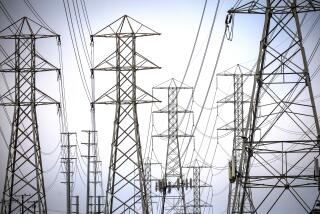Eight ways to beat the heat
There is no single solution to global warming, but renewable, clean energy sources abound, and so do the technologies to put them to use. Here are eight strategies and power sources that can help “fix” global warming, along with their costs now and in the future. If we act, it is very possible to reach the goal of reducing greenhouse emissions 80% over the next 50 years.
--DANIEL M. KAMMEN
The Fix: $30-per-ton carbon-emissions tax
Costs, 2006:
(Avg. cost of electricity in U.S. is 8 cents/kwh; in Calif. it’s 11 cents/kwh.)
About 3 cents per kilowatt-hour and 35 cents per gallon of gas
Costs, 2016: No change
Analysis:
A carbon-emissions tax would make every other “fix” on this list more practical and effective. Taxing carbon emissions, and using the revenues to develop clean energy sources, discourages greenhouse gas production and encourages investments in alternative energy sources. It could be balanced by a reduction in income taxes or other taxes. Many experts figure a $30-per-ton tax would “reorient” the U.S. economy without harming it.
*
The Fix: Energy efficiency
Costs, 2006:
(Avg. cost of electricity in U.S. is 8 cents/kwh; in Calif. it’s 11 cents/kwh.)
Savings of 1 cent/kwh to costs of 3 cents/ kwh
Costs, 2016: Savings of 3 cents/ kwh to costs of 3 cents/kwh
Analysis:
The technologies are readily available, from compact fluorescent lighting to efficient water heaters. Based on the example of California, where aggressive efficiency standards already are in place, all states could cut energy use by 40% or more. Setting standards requires political leadership, and efficiency isn’t a one-time fix -- there must be incentives and investment for continual improvement.
*
The Fix: Solar power
Costs, 2006:
(Avg. cost of electricity in U.S. is 8 cents/kwh; in Calif. it’s 11 cents/kwh.)
At least 20 cents/kwh
Costs, 2016: 10 to 14 cents/kwh
Analysis:
Solar energy systems, including solar thermal systems, could be installed in all homes and businesses. Many of them could produce and export surplus power. The cost of solar electricity systems has fallen by 5% per year for the last decade. Solar is still the most expensive of clean energy technologies, but integrating it directly into buildings could accelerate cost declines.
*
The Fix: Wind power
Costs, 2006:
(Avg. cost of electricity in U.S. is 8 cents/kwh; in Calif. it’s 11 cents/kwh.)
5 to 7 cents/kwh
Costs, 2016: 3 to 6 cents/kwh
Analysis:
Already cheaper than natural gas in the right locations, wind power could be tapped for 15% to 20% of our electricity needs. (Germany is installing wind generators that will supply 10% of its total electricity. North Dakota alone has a greater wind resource than Germany.) Wind power requires land on which to put turbines, but the land can be used concurrently for crops or grazing, and turbines can be sited offshore. The latest designs protect birds.
*
The Fix: Biomass fuel
Costs, 2006:
(Avg. cost of electricity in U.S. is 8 cents/kwh; in Calif. it’s 11 cents/kwh.)
7 to 9 cents/kwh
Costs, 2016: 3 to 6 cents/kwh
Analysis:
Biomass fuel, made from agricultural waste or “energy crops,” can be gasified and blended with natural gas, or made into liquid fuel (ethanol) that could replace one-third or more of gasoline use. Some claim that energy crops could compete with food crops, but the U.S. overproduces food and pays farmers to keep some land out of production.
*
The Fix: Hybrid and ethanol vehicles
Costs, 2006:
(Avg. cost of electricity in U.S. is 8 cents/kwh; in Calif. it’s 11 cents/kwh.)
$2,000 to $5,000 more than conventional cars
Costs, 2016: $1,000 more than conventional cars
Analysis:
Hybrid gas vehicles, or better still, plug-in electric hybrids (especially those that use ethanol instead of gasoline) could reduce U.S. gas consumption by 80% or more. Today’s U.S. automobile fleet gets 25 miles per gallon on average; hybrid technology combined with biofuels could raise that to 100 mpg to 200 mpg. Consumers may need initial incentives and education -- hybrids account for just 1% of new vehicle sales. A distribution network for ethanol is needed.
*
The Fix: Nuclear power
Costs, 2006:
(Avg. cost of electricity in U.S. is 8 cents/kwh; in Calif. it’s 11 cents/kwh.)
At least 3 cents/kwh
Costs, 2016: At least 3 cents/kwh
Analysis:
The nuclear industry has learned to operate existing reactors far more efficiently than in the past, and safety has improved. However, waste management is rife with political and technical problems. Proponents cite nuclear power’s exceptionally low generation cost and zero emissions. Detractors cite its risks and tremendous federal subsidies. Both are right. Trying to create a carbon-free world without nuclear power would be difficult.
*
The Fix: Carbon sequestration
Costs, 2006:
(Avg. cost of electricity in U.S. is 8 cents/kwh; in Calif. it’s 11 cents/kwh.)
About 3 cents/kwh in addition to initial electricity-generating costs
Costs, 2016: No change
Analysis:
Storing carbon dioxide, especially from coal-fired power plants, underground or in the deep ocean has received generous industry funding. This approach may be useful to buy time so other technologies can be developed, but it is ultimately a temporary fix. It comes with the risk of future leakage, and the cost may not fall much because of the uniqueness of each geologic repository.
More to Read
Sign up for Essential California
The most important California stories and recommendations in your inbox every morning.
You may occasionally receive promotional content from the Los Angeles Times.









